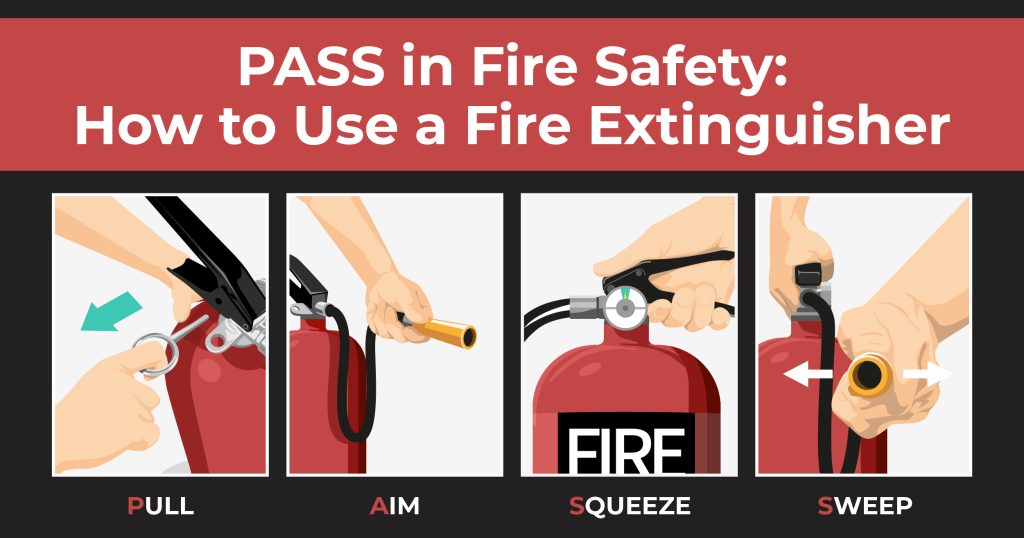Your cart is currently empty!
PASS in Fire Safety: How to Use a Fire Extinguisher
Regardless of whether you’re in your home, your workplace or on an industrial site, fire safety should always be at the top of your list of priorities to help keep you and others around you safe. No fire safety equipment is more effective and useful for this than the humble fire extinguisher. When you’re faced with a small fire, you must understand how to operate a fire extinguisher correctly to save lives.
To help with the above, this month at Fire Safety Equipment, we’re going to discuss the PASS technique, which is a four-step process for using fire extinguishers that everyone should know.

What is PASS?
Firstly, let’s break down what the PASS acronym means.
It stands for Pull, Aim, Squeeze and Sweep. This is an easy way to remember how you’re meant to safely operate a fire extinguisher in an emergency. Now we know what the letters stand for, here’s a more detailed breakdown of each stage of the process:
Pull: Firstly, to prepare the extinguisher for use, you need to pull out the safety pin at the top of the unit. This pin is the locking mechanism that prevents accidental discharge of the unit to ensure it’s fully charged and ready in an emergency.
Aim: Once the pin is out, you can then aim the extinguisher nozzle or hose towards the base of the fire. This is because you want to target the source of the fire – the fuel – where the flames have developed.
Squeeze: Once you have your aim, you then need to squeeze the handle of the fire extinguisher. The suppressant will then be released from the nozzle in the direction of the fire.
Sweep: Now that the extinguisher is activated, you can begin to sweep the hose from side to side, still aiming the stream of suppressant at the base of the fire. This should begin to put out flames and cool the area.
When to Use a Fire Extinguisher
Now you know the PASS process for using a fire extinguisher, but it’s important to remember that you should only use one when it is safe to do so. Fire extinguishers should only be used for small fires that you’re confident you can handle by yourself. If the fire is too large and it is no longer appropriate to use an extinguisher, you should raise the alarm, evacuate the building and call the fire and rescue services.
Types of Fire Extinguishers
Here in the UK, there are multiple fire extinguisher types to help you put out various fire types. This is because different fuels require a different approach in order to be effective.
- Water Extinguishers: Suitable for Class A fires (e.g. wood, paper, textiles)
- Foam Extinguishers: Suitable for Class A and B fires (e.g. flammable liquids like petrol and oil)
- Powder Extinguishers: Suitable for Class A, B, and C fires and some electrical fires
- Carbon Dioxide (CO2) Extinguishers: Suitable for electrical fires
- Wet Chemical Extinguishers: Suitable for Class F fires (e.g. cooking oils and fats)
- Lith-ex Extinguishers: Suitable for lithium-ion battery fires (e.g. phones and tablets)
To fully put out any fire, you need to make sure you have the right fire extinguishers on hand to get the job done. You can learn more about the different fire classes in our previous post. Once you know which type will best suit the risks in your building, you can browse our range of extinguishers and order online for swift delivery.
Knowing how to properly use a fire extinguisher can make a huge difference, potentially preventing major damage and protecting lives. Using the PASS technique, combined with your knowledge of the different fire extinguisher types, will help to form part of your fire safety protocols. You should, however, always prioritise your safety and the safety of those around you over any property — don’t hesitate to call 999 when faced with a fire you cannot handle.
For all your essential fire safety equipment, look no further than our products at Fire Safety Equipment. From extinguishers and fire signage to accessories and other workplace safety products, you’ll find it all in one handy place, with free delivery in the UK.

